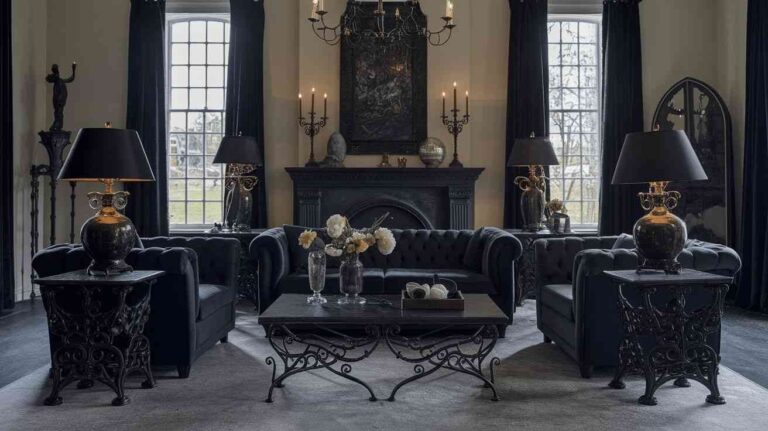Let’s talk about bringing some gothic drama into your living room.
Not the teenager-with-black-nail-polish kind (though that has its place too).
I mean that rich, moody, sophisticated dark style that makes a room feel both timeless and totally modern.
Gothic style has grown up. It’s shed the cobwebs and plastic bats but kept all the drama and intensity.
Today’s modern gothic living spaces blend historical elements with clean contemporary lines, creating rooms that feel both mysterious and welcoming at the same time.
Ready to walk on the dark side? Here’s how to create a modern gothic living room that’s more “elegant mansion” than “haunted house.”
Modern gothic isn’t about recreating a medieval castle. It’s about capturing that moody, dramatic feeling while keeping things livable and current.
Think deep colors, rich textures, and statement pieces that command attention without overwhelming the space.
This style works whether you’re going all-in or just adding gothic touches to your existing decor.
The key is balance – darkness with light, ornate with simple, historic with modern.
Embrace a Deep Color Palette
The foundation of any gothic-inspired space starts with color.
Forget beige – we’re talking deep, rich hues that create instant atmosphere.
Dark blues, purples, greens, and grays work beautifully as wall colors.
True black can be fantastic but might feel overwhelming in smaller spaces.
Navy or charcoal often gives you that same dramatic effect while staying more livable.
Don’t feel like you need to paint every wall dark.
Sometimes just one accent wall in a deep tone creates enough impact, especially when paired with lighter neutrals elsewhere in the room.
What makes this modern rather than traditional gothic? The key is keeping the colors sophisticated rather than cartoonish.
Think jewel tones and complex neutrals – burgundy instead of bright red, forest green instead of lime.
Choose Statement Gothic Furniture
The right furniture makes or breaks a gothic living room.
Look for pieces with presence and personality.
High-backed chairs, tufted sofas, and furniture with carved details all nod to gothic style without screaming “Halloween decoration.”
Starting with textiles, dark wood and tufted velvet seating is an excellent choice for creating that luxurious gothic feel.
For a modern twist, mix ornate pieces with cleaner lines.
A sleek modern sofa paired with an ornate side table creates that perfect tension between old and new.
Don’t overlook shape, either.
Gothic style loves curves, points, and dramatic silhouettes.
Even a simple chair with a unique shape can contribute to the gothic vibe without being over-the-top.
Incorporate Dramatic Lighting
Lighting might be the most important element in gothic design.
It creates mood, highlights architectural features, and adds that mysterious glow that defines the style.
Wall sconces cast interesting shadows.
Pendant lights with black or metallic finishes make strong statements. And floor lamps with dramatic shades direct light exactly where you want it.
For peak gothic vibes, consider a chandelier – not necessarily crystal, but something with visual weight.
Modern versions made from matte black metal or smoky glass offer that gothic drama without the dusty castle feel.
Don’t forget about the actual quality of light.
Warm bulbs (around 2700K) create a much more welcoming glow than cool white lights, which can make dark rooms feel cold and unwelcoming.
Add Dark, Textured Walls
Plain painted walls are fine, but texture takes gothic to another level. Consider options like textured wallpaper, dark wood paneling, or decorative molding to add dimension.
Flocked damask patterns offer instant gothic credentials.
For something more subtle, try textured paint techniques or even fabric wall coverings in dark velvet or linen.
If you’re renting or not ready to commit, temporary wallpaper comes in amazing gothic-friendly patterns.
Even a large textile hanging can add that textural dimension without changing your walls.
When choosing patterns, look for motifs like damask, florals, or geometric designs with a bit of complexity. The goal is sophisticated richness, not busy confusion.
Highlight Architectural Details
Gothic style loves architectural drama.
If you’re lucky enough to have high ceilings, arched doorways, or decorative moldings, emphasize them.
Paint trim in contrasting colors to make it pop against dark walls.
Add picture rail molding or wainscoting to create architectural interest where none exists.
For modern gothic, you don’t need ornate Victorian details. Clean-lined moldings painted in dark colors can create that same structured feeling while staying contemporary.
Don’t overlook the ceiling.
A dark ceiling can actually make a room feel larger and more dramatic.
If that’s too much, even painting the ceiling a lighter shade of your wall color creates more dimension than plain white.
Use Luxurious Fabrics
Gothic style is all about sensory richness.
Velvet, silk, brocade, leather – these fabrics add depth through both texture and light-reflecting properties.
Layer different textures for maximum impact. Smooth leather against nubby wool. Sleek silk next to plush velvet.
These contrasts create visual and tactile interest.
For window treatments, heavier fabrics like velvet create that sumptuous feel.
If they’re too heavy for your climate, even sheer black curtains can add gothic drama while still letting in light.
Don’t forget about comfort.
All the visual drama in the world won’t matter if your furniture feels terrible. Make sure your gothic lair is actually somewhere you want to spend time.
Integrate Metallic Accents
Metal elements add essential contrast and reflection in a dark room.
Gold, bronze, copper, and black metals all work beautifully in gothic spaces.
Consider metal frame coffee tables, lamp bases, mirror frames, or decorative objects.
The shine creates welcome points of light in a darker room.
For modern gothic, brushed or matte finishes often work better than high polish.
They add sophistication without the blingy feel that can push things toward gaudy.
Mix metals cautiously.
Two complementary metals (like black and gold living room) usually work better than a free-for-all of every finish.
Display Gothic Artwork
Art sets the tone for any room, and gothic-inspired spaces are no exception.
Look for pieces with moody atmospheres, dramatic subjects, or dark color palettes.
Modern abstract art in dark colors works just as well as traditional gothic subjects.
The key is emotional impact rather than specific imagery.
Vintage anatomical drawings, botanical prints, or landscapes with dramatic skies all contribute to gothic vibes.
Frame them in dark or metallic frames for maximum impact.
For a budget-friendly option, vintage book plates or even digital prints can look amazing when properly framed and displayed.
Incorporate Dark Wood Elements
Wood brings natural warmth to gothic spaces, preventing them from feeling cold or uninviting.
Dark stained furniture, flooring, or architectural standard elements add richness. Look for mahogany, walnut, ebony, or even painted black wood.
The grain pattern in wood adds natural texture and variation.
Even in small doses, like picture frames or side tables, dark wood makes a gothic space feel more grounded.
If authentic wood is outside your budget, many laminate options mimic the look surprisingly well for larger surfaces like vinyl flooring.
Add Modern Minimal Gothic Decor
The key to modern gothic is restraint. Instead of cluttering every surface, choose fewer, more impactful pieces.
Look for objects with strong silhouettes, unusual shapes, or interesting materials.
A single large skull object makes more impact than a collection of small ones.
Modern gothic loves contrast. Pair antique-looking objects with very modern ones for that perfect tension between old and new.
Remember that negative space is your friend. Leaving some emptiness allows your statement pieces to shine without competition.
Use Mirrors Strategically
Mirrors are gothic magic. They reflect light, create illusion, and add sparkle to dark rooms.
Large mirrors with ornate or interesting frames make powerful statements.
Position them to reflect windows or light sources for maximum brightness.
For modern gothic, try unconventional mirror shapes or finishes. Smoky glass, antiqued mirrors, or unusual geometric shapes keep things contemporary.
Grouping smaller mirrors creates gallery-like impact while still bouncing light around the room.
Create a Focal Fireplace
Nothing says gothic like a fireplace focal point. If you have one, make it the star of your room.
Paint the mantel dark or add gothic-inspired accessories.
Candles, dark artwork, or metal objects all enhance the fireplace’s natural drama.
No real fireplace? Electric versions have come a long way and can create that same cozy focal point. Even candle groupings can create a similar effect on a smaller scale.
Consider the area above the fireplace too.
A large mirror, striking artwork, or even a wall sculpture makes the entire wall a dramatic feature.
Play with Patterns and Layers
Gothic style thrives on complexity. Layering patterns adds depth without making things feel busy.
Mix scale when combining patterns.
A large damask might work with a smaller geometric if their colors coordinate. The key is keeping some common element between them.
Don’t just think flat patterns. Three-dimensional textural patterns from throw pillows, rugs, or upholstery add another layer of interest.
For a modern take, try unexpected pattern combinations. Traditional gothic motifs paired with very contemporary ones creates that perfect old-meets-new tension.
Add Touches of Nature
Gothic has always had a connection to the natural world. Plants and natural elements balance all the dark drama.
Dark foliage plants like snake plants, ZZ plants, or black mondo grass add living texture while maintaining the color scheme.
Dried elements like pampas grass, branches, or preserved plants offer natural shapes without maintenance needs.
For a subtle gothic touch, look for planters in black, metallic, or jewel tones rather than bright ceramic pots.
Balance Darkness with Light
The most successful gothic rooms understand the importance of light.
Without some brightness, dark elements disappear into murky shadows.
Strategic lighting highlights your best features.
Make sure dark corners have some illumination through table lamps, sconces, or carefully directed overhead lights.
Light colored accents provide crucial contrast.
Even in the darkest room, some cream, silver, or pale gold elements help define the space.
Window treatments should balance privacy with light needs. Consider top-down blinds or sheers that still allow natural light while maintaining the moody atmosphere.
Conclusion
Creating a dark modern gothic living room isn’t about following strict rules.
It’s about capturing a feeling of dramatic sophistication that balances historical references with contemporary comfort.
The beauty of this style is its flexibility. You can go full vampire castle or just add subtle gothic touches to your existing decor.
Either way, embracing darker elements creates spaces with depth, personality, and undeniable atmosphere.
After all, there’s something uniquely comforting about a room that wraps you in rich, dark elegance.
In a world of bright white interiors and minimal beige, going gothic offers a refreshingly different approach to making your living space truly yours.



